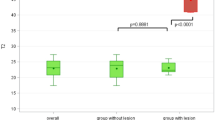Abstract
Objective. The objectives of the current study were (1) to quantify the incidence of increased T2 signal in the distal clavicle and (2) to assess the clinical significance of this finding in patients with chronic acromioclavicular (AC) joint pain.
Design and patients. Eight patients (five male and three female, 15–41 years of age) with disabling shoulder pain localized to the AC joint and marked increased T2 signal in the distal clavicle are presented. These eight patients underwent MR examination over a 25 month period (August 1996 to September 1998). The dictated reports of all shoulder MR examinations conducted over this same time period were reviewed retrospectively for the presence of signal abnormality in the distal cla-vicle. Clinical data and, in five patients, findings at shoulder arthroscopy or open surgery, were correlated with the results of MR imaging. One patient underwent arthroscopy on both shoulders.
Results. The selected eight patients each presented clinically with disabling shoulder pain localized to the AC joint. One patient is presented twice, as both shoulders were symptomatic (n=9). Plain film examination (9/9) failed to indicate a structural cause of shoulder pain in any of the patients. MR examination demonstrated abnormally increased T2 signal in the distal clavicle in all nine cases and no other cause for AC joint pain. Three patients responded to a course of conservative therapy. Six experienced refractory pain despite conservative therapy. Resection of the distal clavicle was performed in five of the six cases. All patients who underwent resection of the distal clavicle experienced complete resolution of AC joint pain. A retrospective review of the dictated reports for all shoulder MR imaging examinations performed at out institution over a 25 month period (August 1996 to September 1998; n=761) demonstrated a 12.5% incidence of abnormally increased T2 signal in the distal clav-icle.
Conclusions. Increased T2 signal in the distal clavicle is a relatively common finding (12.5%) on MR imaging examinations of the shoulder and in most cases is of no clinical significance. However, in patients with chronic AC joint pain and no other abnormality on plain film or MR imaging, increased T2 signal may represent an early manifestation of, or a process similar to, osteolysis of the distal clavicle. Patients with this presentation who continue to suffer from disabling pain following conservative therapy may benefit from surgical resection of the distal clavicle.
Similar content being viewed by others
Author information
Authors and Affiliations
Additional information
Received: 7 February 2000 Revision requested: 21 March 2000 Revision received: 14 August 2000 Accepted: 17 August 2000
Rights and permissions
About this article
Cite this article
Fiorella, D., Helms, C. & Speer, K. Increased T2 signal intensity in the distal clavicle: incidence and clinical implications. Skeletal Radiol 29, 697–702 (2000). https://doi.org/10.1007/s002560000284
Issue Date:
DOI: https://doi.org/10.1007/s002560000284




